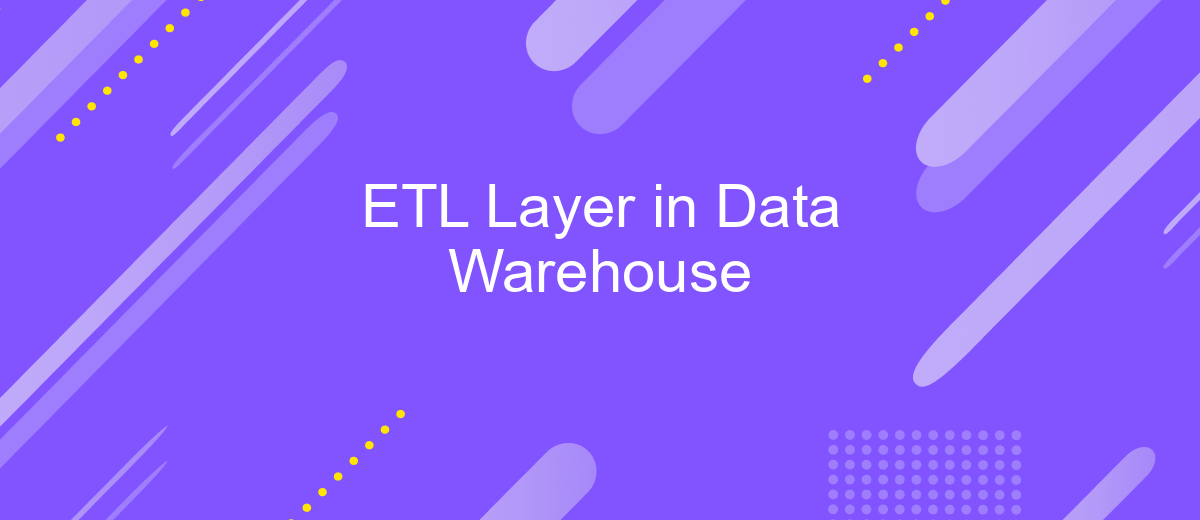ETL Layer in Data Warehouse
The ETL (Extract, Transform, Load) layer is a crucial component of any data warehouse system. It serves as the backbone for data integration, ensuring that data from various sources is accurately extracted, transformed into a usable format, and loaded into the warehouse. This process enables organizations to make informed decisions based on comprehensive, consistent, and up-to-date data.
Introduction
In today's data-driven world, the ETL (Extract, Transform, Load) layer plays a crucial role in the architecture of data warehouses. It is responsible for extracting data from various sources, transforming it into a suitable format, and loading it into the data warehouse for analysis and reporting. This process ensures that the data is accurate, consistent, and readily available for decision-making.
- Extraction: Gathering data from multiple sources, such as databases, APIs, and flat files.
- Transformation: Converting data into a consistent format, cleaning, and enriching it.
- Loading: Inserting the transformed data into the data warehouse.
Effective ETL processes are critical for the success of any data warehouse. Tools like ApiX-Drive can simplify the integration of various data sources, automating the extraction and transformation processes. By leveraging such services, organizations can ensure seamless data flow and maintain high data quality, ultimately supporting better business insights and decisions.
ETL Process Overview

The ETL process, which stands for Extract, Transform, Load, is a critical component in the architecture of a data warehouse. This process involves extracting data from various source systems, transforming it into a suitable format, and loading it into the data warehouse for analysis and reporting. During the extraction phase, data is collected from multiple sources such as databases, APIs, and flat files. The transformation phase involves data cleaning, normalization, and enrichment to ensure consistency and accuracy. Finally, the loading phase transfers the transformed data into the data warehouse, where it becomes available for querying and analysis.
Integrating various data sources can be complex and time-consuming. Services like ApiX-Drive simplify this process by providing automated data integration solutions. ApiX-Drive enables seamless connections between different applications and databases, reducing the need for manual intervention and minimizing errors. By leveraging such services, organizations can streamline their ETL processes, ensuring timely and accurate data flow into their data warehouses. This not only enhances data quality but also accelerates the time-to-insight, empowering businesses to make data-driven decisions more efficiently.
ETL Architectures

ETL architectures are critical for the efficient processing and transformation of data in data warehouses. These architectures define how data is extracted from various sources, transformed into a suitable format, and loaded into the data warehouse for analysis and reporting. Different architectures cater to different needs and complexities of data integration.
- Batch Processing: This traditional ETL architecture processes data in large batches at scheduled intervals, making it suitable for non-real-time data integration.
- Real-Time Processing: This architecture allows for continuous data processing and integration, providing real-time insights and updates.
- Hybrid Processing: A combination of batch and real-time processing, this architecture offers flexibility to handle both periodic and continuous data integration needs.
Choosing the right ETL architecture depends on the specific requirements of the organization. For instance, services like ApiX-Drive can simplify the integration process by offering automated workflows and real-time data synchronization, making it easier to manage complex data pipelines. By leveraging such tools, organizations can ensure seamless and efficient data integration, enhancing the overall performance of their data warehouses.
Data Transformation and Integration

Data transformation and integration are critical components of the ETL process in a data warehouse. Transformation involves converting raw data into a format that is suitable for analysis. This step may include data cleansing, normalization, aggregation, and enrichment to ensure the data is accurate and consistent.
Integration, on the other hand, involves combining data from multiple sources into a single, unified view. This step is essential for providing a comprehensive understanding of the data and enabling more informed decision-making. Effective integration ensures that data from various systems and applications can be seamlessly accessed and analyzed together.
- Data Cleansing: Removing inaccuracies and inconsistencies.
- Normalization: Standardizing data formats.
- Aggregation: Summarizing data for easier analysis.
- Enrichment: Adding valuable information to the data.
Tools like ApiX-Drive can simplify the integration process by automating the connection between different data sources. This service allows users to set up integrations quickly and effortlessly, ensuring that data flows smoothly from one system to another. By leveraging such tools, organizations can enhance their data transformation and integration efforts, leading to more reliable and actionable insights.
ETL Best Practices
Implementing ETL best practices is crucial for maintaining data integrity and ensuring efficient data processing. Firstly, always validate and clean data at the extraction stage to avoid propagating errors. Utilize robust data validation rules to identify and handle anomalies early. Secondly, ensure your ETL processes are well-documented and maintain comprehensive logs. This practice helps in troubleshooting issues and provides a clear audit trail for data lineage.
Automation is another key aspect to consider. Tools like ApiX-Drive can streamline the integration of various data sources, reducing manual effort and minimizing the risk of errors. Additionally, schedule ETL jobs during off-peak hours to optimize system performance and avoid conflicts. Regularly monitor and optimize ETL workflows to adapt to changing data volumes and business needs. Implementing these best practices will enhance the reliability and scalability of your data warehouse.
FAQ
What is ETL in the context of a Data Warehouse?
Why is ETL important for data warehousing?
What are the main challenges associated with ETL processes?
How can I automate ETL processes?
What are the best practices for ETL in a data warehouse?
Do you want to achieve your goals in business, career and life faster and better? Do it with ApiX-Drive – a tool that will remove a significant part of the routine from workflows and free up additional time to achieve your goals. Test the capabilities of Apix-Drive for free – see for yourself the effectiveness of the tool.

